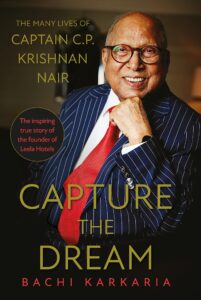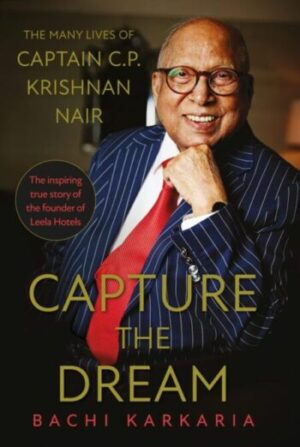Capture the Dream
The Many lives of Captain C.P. Krishnan Nair
Bachi Karkaria.

“It was easy to see why Captain Nair took to Bombay like a prawn to Malabar curry.” Observes Bachi Karkaria in her rollicking biography of Captain C.P.Krishnan Nair, entrepreneur and creator of the Leela Hotel chain of luxury hotels.
She adds “Like him, the city thrived on its chutzpah. It didn’t wait for opportunity to knock; instead, its door was always open….It didn’t worry about the caste, creed or colour of those who came to its altar, as long as they knew how to make money with passion and use it with compassion. Captain Nair too had a hard head and a soft heart.”
Like the prawn we presume.
Prawns actually appear at regular intervals in the life and travels of Captain Nair as portrayed by Bachi. There is a much talked about prawn pickle made by his doting mother Madhavi Amma from her village near Kannur in North Malabar. She hands her freshly made prawn pickle to Kanakkamma, the wife of V.P. Menon to pass on to young Krishnan Nair in New Delhi. This is how he meets the redoubtable Uncle VP, who becomes his entre into a whole new world of influencers as we might term them now.
There is the remembrance of fish curries made and served at their table, by Leela, his wife and collaborator, whose name appears on every premium brand that Captain Nair’s created in all the more adventurous gambles undertaken by him from their home in what is now called Mumbai. She was the inspiration for him to buy the machinery for what became Leela Scottish Lace, a popular brand that graced both the bodies and homes of celebrities. In the numerous photographs that have been included, we are treated to a picture of the young Rajesh Khanna wearing a shirt made from the fabric. It was also used to grace the interiors we are told of Hollywood greats, such as Gregory Peck. Sadly, there is no picture of Peck impeccably clad in purple Leela Lace.
Before Leela Lace, Captain Nair had made his mark on the American imagination by exporting the plaid, or checked, pure cotton yardage woven in the South India known as “Bleeding Madras”. Its USP was that the natural dyes used were guaranteed to “run” thereby creating seemingly new clothes after every wash. There was also the fine cheesecloth like fabrics, or those that became another trademark the “Seersucker” suiting material that created the smart casuals of that era.
It’s difficult not to imagine Captain Nair emerging from Bachi’s account as a Malayali version of the famous Hollywood movie character Forrest Gump. Despite not being a “Midnight’s Child” having been born sometime before Independence, Nair’s own account of his life, translated into English from the original Malayalam, forms the basis for these early episodes. Bachi transforms them into a series of intimate folk tales of his life, whereby at every crossroads of history, Nair is waiting to step forward and add his contribution to the evolving narrative of India on its road to freedom and greatness.
For instance, when he finds he has no money to travel to Madras, the capital of the Madras Presidency where all aspiring students gravitated, he appeals for help from one of his earliest patrons- the Chirakkal Raja. Alas, the Raja tells him he has fallen into bad times and has no money himself. Seeing the young Krishnan Nair’s shining face before him he is moved to remove his diamond ring from his finger and tells him to take it to “Bapalal” who would redeem the diamond. As everyone in present day Chennai knows, Bapalal is still one of the trusted jewelers in the City and of course, they did indeed honour the Raja’s trust.
Another story seems almost a repetition of one told by V.P. Menon to his biographer Harry Hodson in the presence of his step-daughter Meenakshikutty, when he had retired to Bangalore. It appeared in the Readers’ Digest at the time. In this version, when the young Menon finds himself alone and penniless on the platform in New Delhi for the first time, a kindly Sikh gentleman makes a small donation of money. When Menon promises to pay him back, the Sardar smiles and asks him to “pay it forward” when he finds someone else in the same position.
We are told that the same sequence of events takes place as the young Krishnan Nair arrives at his destination at Peshawar, on his way to Abbottabad to join his army unit. Except in his case, it’s an elderly Nair gentleman who gives him the handout and the same advice to ‘pay it forward’.
I must pause here to make a confession. As a fellow practitioner in the fine art of spinning tales, I have to admit that I have known Bachi over a couple of decades. I cannot be presumed to be wholly impersonal in recommending the book under review. I am even mentioned in the very generous acknowledgements at the end along with a colleague of hers, Suresh Nair. Except for the portions relating to my memories of V.P. Menon, and close associate to the Iron Man of India, Sardar Vallabhbhai Patel, there is little I could have really shared with Bachi about the social customs of North Malabar, or more exactly the area around Kannur, which is where Captain Nair lived his early life.
What is remarkable is how Bachi has managed to intuitively create a warm and intimate picture of those years where the young lad, Krishnan, as she refers to him, grew up under the care of his mother Madhavi Amma. There are references to the spartan childhood when all she could afford to give her son was the rice-gruel before sending him off to the local school. Some of it reads like a chapter out of the life of Pip the hero of Charles Dickens’ ‘Great Expectations’ who has to make his fortune in an uncharted future filled with obstacles.
When he decided to become a Communist, he becomes friendly with A.K. Gopalan, the best known of the early Marxist ideologues in Kerala, though here, Bachi cannot resist adding a bit of spice about Gopalan’s young wife. She fails to acknowledge how Susheela Gopalan became a well-known activist in her own right. At the time of the famous Haripura Congress session in 1938, he came under the spell of Subhas Chandra Bose. Subsequently, he joins the Army, travels to Abbottabad in what was then the North West Frontier Province and meets the Frontier Gandhi, Khan Abdul Gaffar Khan, his equally famous brother, Dr. Khan Sahib and the rest of the statesmen of the time.
The first half of the book is a treat for readers with a historical inclination; the second half will be of interest for those charting the rise and rise of Captain Nair’s dream run as a hotelier after he entered his sixties. The vision and energy with which he created a remarkable range of hotels across the country, each with its own unique style of architecture, gardens, hospitality and ability to attract a top-grade clientele, forms the engrossing second half of the book. The success of the Leela Hotel chain is amply illustrated by the photographs showing the great and the powerful personalities that passed through its portals.
At the same time, there is something of the Russian folk tale of the Golden Fish even here. After three decades of its growth, the sustainability of the Leela Hotels appeared to be slipping out of control. In the folk tale, the old fisherman and his wife who had wanted more and more until circumstances forced them to turn the clock black and be content. Or as we are told: “They sat down together, the old fisherman and his wife and drank tea without sugar, but at peace with each other”.
This is not however the way that Bachi ends her story. The family has continued to thrive.
Towards the end of his life, eight months before he passed away, as the text tells us, Captain Nair was awarded an honorary doctorate in 2013, by the Jodhpur University for his contributions to the Indian hotel industry. Maybe, even as he stood there on the podium to receive the award, Captain Nair was also aware that after 32 years at the helm, his empire was about to be passed on to other more ambitious owners.
Yet this is what he had to tell his audience.“My message today is simple. Whatever dream you choose to pursue, take pride in it. Aim at being the best of the best. Nothing is guaranteed, and everything is possible. Go forth with courage and resilience. Life will not be necessarily smooth- but the script is yours to write.”
His final piece of luck was that to mark his birth centenary in February of 2022, he was fortunate to find Bachi Karkaria to re-write his script with wit and boundless affection.
Geeta Doctor. 17th May 2022

